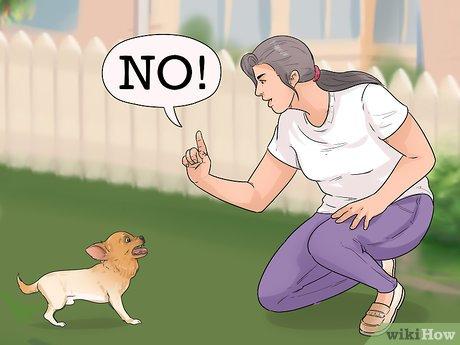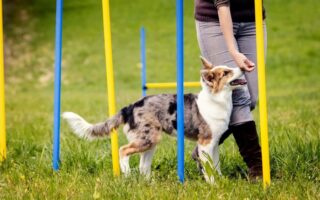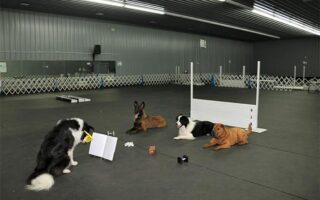Bringing a dog into your life is a joyful experience, filled with boundless energy, wagging tails, and unconditional love. Yet, along with the joyous moments come the challenges of training and discipline. Our furry companions thrive on structure and understanding, but navigating the waters of effective dog discipline can often feel overwhelming for even the most dedicated pet owner. What’s the best way to ensure your dog learns proper behavior while still fostering a strong bond of trust? In this article, we will explore the most effective methods for disciplining your dog, blending positive reinforcement with clear boundaries, all while ensuring that love and respect remain at the heart of your relationship. Join us as we uncover the best practices for guiding your canine friend towards becoming a well-mannered member of your family.
Table of Contents
- Understanding Your Dogs Behavior
- Positive Reinforcement Techniques for Effective Training
- Setting Clear Boundaries and Consistency
- The Importance of Patience and Persistence in Discipline
- Q&A
- In Conclusion
Understanding Your Dogs Behavior
Understanding your dog’s behavior is crucial for effective training and discipline. Dogs communicate through body language and vocalizations, which can reveal their emotional state and intentions. Pay attention to cues such as a wagging tail, relaxed ears, and the position of their body. These signals can indicate happiness or excitement, while a lowered tail, flattened ears, and avoidance behaviors might suggest fear or discomfort. Recognizing these signs will help you choose the right approach to discipline, ensuring it aligns with your dog’s emotional needs and fosters trust.
Positive reinforcement is a powerful tool in shaping your dog’s behavior. Instead of focusing solely on punishing undesirable actions, consider the following strategies to encourage good behavior:
- Reward Good Behavior: Use treats, praise, or playtime to reinforce positive actions.
- Establish Clear Commands: Consistency is key. Use the same words or signals for commands to avoid confusion.
- Provide Structure: A routine can help your dog know what to expect, reducing anxiety and behavioral issues.
- Redirect Negative Behavior: Instead of scolding, redirect your dog’s focus to a more appropriate activity.
Positive Reinforcement Techniques for Effective Training
Utilizing positive reinforcement techniques can transform your dog’s training experience into a rewarding and enjoyable process. By offering certain rewards every time your dog exhibits the desired behavior, you not only reinforce good habits but also build a stronger bond between you and your furry friend. Key rewards can include:
- Treats: Small, tasty rewards motivate dogs and encourage them to repeat desired actions.
- Praise: Use an enthusiastic tone to verbally acknowledge their good behavior.
- Toys: Offering a favorite toy can be an exciting reward for energetic pups.
- Playtime: Engaging in a fun activity immediately after a successful command reinforces positive behavior.
To implement effective positive reinforcement, timing is crucial. Rewards should be given immediately after the desired behavior to create a clear connection in your dog’s mind. Additionally, varying the rewards can keep your pup engaged and interested in training sessions. You can incorporate a simple table for reference on reward types and timing:
| Reward Type | Timing for Reward |
|---|---|
| Treat | Immediately after action |
| Praise | As soon as behavior is noticed |
| Toy | During play sessions |
| Playtime | Right after completing a task |
Consistently applying positive reinforcement will encourage your dog to learn and repeat good behaviors while fostering a positive environment for both of you. It’s not just about correcting unwanted actions; it’s about celebrating and reinforcing the behaviors you want to see thrive.
Setting Clear Boundaries and Consistency
Establishing clear boundaries is crucial in shaping your dog’s behavior. Dogs thrive on structure and understanding what is expected of them. Consistent rules help them feel secure and minimize confusion. To effectively set boundaries, consider the following key points:
- Define Specific Areas: Clearly indicate which areas of the home are off-limits or where certain behaviors are unacceptable.
- Use Consistent Commands: Always use the same verbal cues for commands to avoid mixed signals.
- Reinforce Positive Behavior: Reward your dog immediately when they comply with established rules to encourage repetition.
Consistency across all family members is also vital. If one person allows certain behaviors while another corrects them, it leads to frustration for the dog and undermines training efforts. To maintain uniformity, a few strategies can be beneficial:
| Strategy | Description |
|---|---|
| Family Meetings | Regularly discuss and agree on rules so everyone is on the same page. |
| Training Sessions | Involve all family members during training to ensure everyone uses the same approach. |
| Documentation | Create a chart of commands and rules for easy reference. |
The Importance of Patience and Persistence in Discipline
Disciplining a dog effectively requires a blend of patience and persistence. Dogs, much like humans, have varying learning speeds and temperaments. It’s easy to become frustrated when your furry friend doesn’t grasp commands immediately, but maintaining a patient demeanor is essential. This calm approach not only fosters a positive learning environment but also enhances the bond of trust between you and your dog. When you display patience, you allow your dog the necessary time to process instructions, making it more likely for them to understand and comply in the long run.
Furthermore, persistence is a key ingredient in reinforcing discipline. Even when faced with setbacks, consistently applying commands and expectations empowers your dog to learn boundaries and behavior. To aid in this journey, consider the following strategies:
- Use Consistent Commands: Employ the same words and tones for commands to eliminate confusion.
- Reward Progress: Celebrate small successes with treats or praise, reinforcing positive behavior.
- Set Realistic Goals: Understand that learning takes time. Aim for small, achievable milestones.
When implementing these strategies with patience and persistence, consider tracking your dog’s progress to identify patterns and enhancements in their behavior. A simple table can showcase daily training moments, capturing both successes and areas for improvement:
| Day | Command Practiced | Success Rate |
|---|---|---|
| 1 | Sit | 70% |
| 2 | Stay | 50% |
| 3 | Come | 80% |
By integrating patience and persistence into your training routine, you create a structured atmosphere where your dog can thrive, leading to a more harmonious relationship as they learn what behaviors are acceptable.
Q&A
Q: What is the best way to discipline a dog?
A: The best way to discipline a dog centers around positive reinforcement and consistent training. Instead of focusing on punishment, it’s essential to encourage good behaviors through rewards and praise, which reinforces the bond between you and your furry companion.
Q: Why is positive reinforcement preferred over punishment?
A: Positive reinforcement builds trust and creates a more harmonious relationship between you and your dog. It encourages learning without fear or anxiety. Dogs respond better when they associate good behavior with rewards, making them more likely to repeat those actions.
Q: What types of rewards work best for dogs?
A: Rewards can be tangible, like treats, or intangible, like praise and affection. Identifying what your dog values most—be it a favorite toy, belly rubs, or tasty treats—will help you deliver effective reinforcement. Experiment with different rewards to see what excites your dog the most!
Q: How can I correct undesirable behaviors in my dog?
A: Instead of using harsh corrections, redirect your dog’s behavior. For example, if your dog jumps on guests, teach them to sit when visitors arrive. When they comply, reward them immediately. This approach allows your dog to understand what is expected, gradually reducing unwanted behaviors.
Q: What role does consistency play in dog training?
A: Consistency is key! Use the same commands and rewards every time to help your dog understand what you expect. Everyone in your household should be on the same page to prevent confusion. Dogs thrive on routine; establishing predictable patterns helps reinforce learning.
Q: How should I handle accidents or misbehaviors?
A: Accidents and misbehaviors are opportunities for learning. If your dog has an accident indoors, avoid punishment. Instead, clean it up and take them outside more frequently to reinforce desired bathroom behavior. If a behavior like chewing occurs, redirect to an appropriate chew toy instead of scolding.
Q: Are there any training tools or methods I should consider?
A: Various tools, such as clickers and training collars, can aid in training but should be used judiciously. Clicker training, for instance, can effectively mark desired behaviors for reinforcement. Always pair tools with positive techniques, and never resort to punitive measures.
Q: How can I ensure my dog understands my training?
A: Keep training sessions short and fun, incorporating plenty of praise and rewards. Use clear commands and gestures, and be patient. Repetition is essential—practice consistently and gradually increase the complexity of tasks as your dog learns. Remember, training is an ongoing journey!
Q: Can all dogs be trained this way?
A: Yes, most dogs can be trained using these methods, although individual personalities and temperaments may influence the process. Some breeds may require more patience, while others might pick up commands quickly. Tailor your approach to suit your dog’s unique needs and learning style.
Q: What if I struggle with training my dog on my own?
A: Seeking help from a professional dog trainer or attending obedience classes can provide valuable guidance. Professionals can offer insights tailored to your dog’s behavior and your training style, making the learning experience enjoyable for both of you.
Q: What’s the overall takeaway regarding dog discipline?
A: The essence of effective dog discipline lies in fostering a trusting, respectful relationship through positive methods, consistency, and understanding. Focus on what your dog does well, guide them gently, and celebrate their successes. Training should be a bonding experience, not a battle!
In Conclusion
finding the best way to discipline your dog is not simply about enforcing rules; it is an art that intertwines understanding, patience, and love. Whether you lean toward positive reinforcement, setting clear boundaries, or employing gentle correction, the key is consistency and clear communication with your furry companion. Remember that every dog is unique, and what works for one may not work for another. Take the time to observe your dog’s behavior, adjust your methods accordingly, and celebrate the small victories along the way. With the right approach, you will nurture not only a well-behaved pet but also a deep, trusting bond that will enrich both your lives. Happy training!



